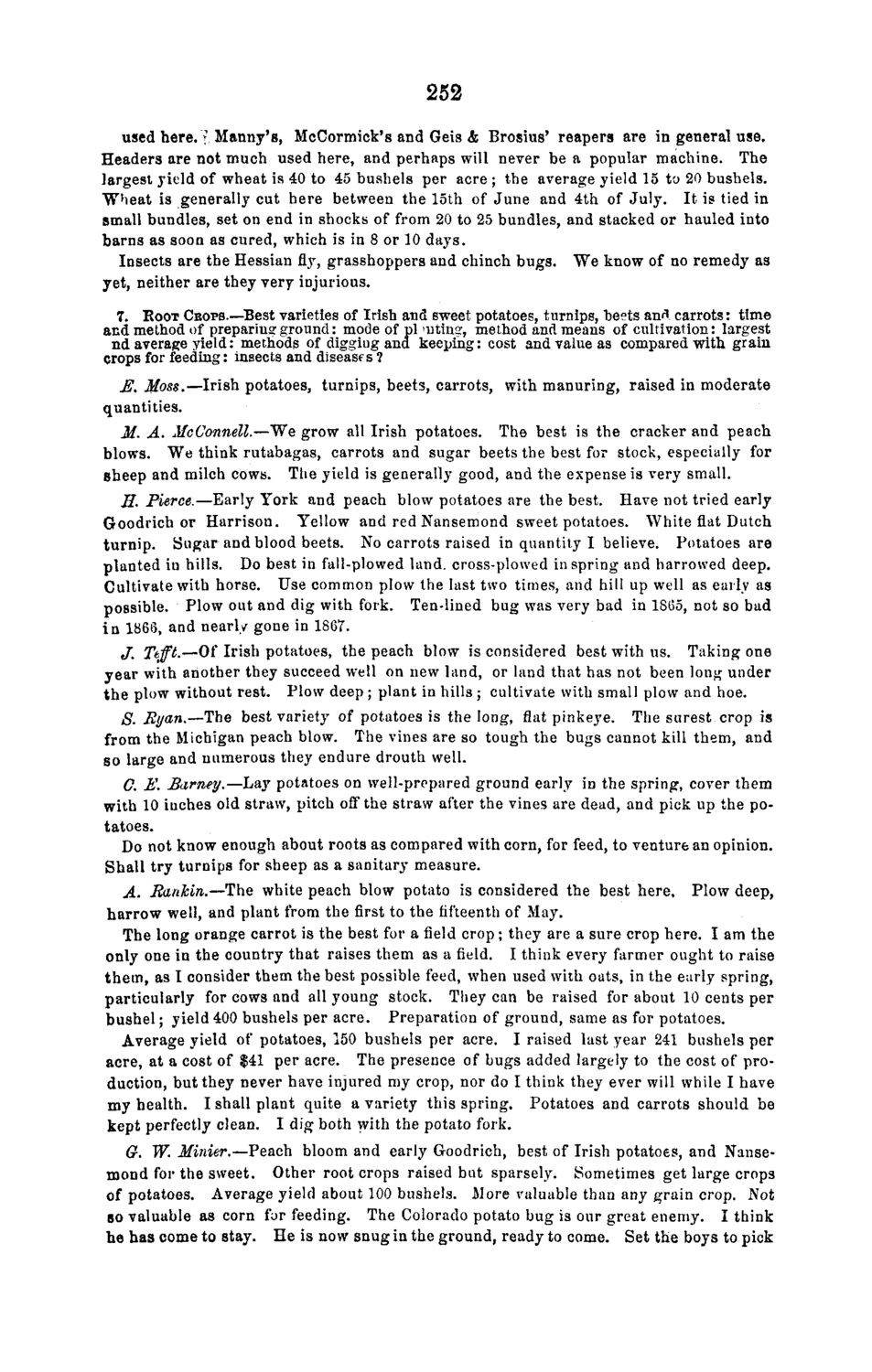| |
| |
Caption: Board of Trustees Minutes - 1868
This is a reduced-resolution page image for fast online browsing.

EXTRACTED TEXT FROM PAGE:
252 used here. | Manny's, McCormick's and Geis & Brosius' reapers are in general use. Headers are not much used here, and perhaps will never be a popular machine. The largest yield of wheat is 40 to 45 bushels per acre ; the average yield 15 to 20 bushels. Wheat is generally cut here between the 15th of J u n e and 4th of July. It is tied in small bundles, set on end in shocks of from 20 to 25 bundles, and stacked or hauled into barns as soon as cured, which is in 8 or 10 days. Insects are the Hessian fly, grasshoppers and chinch bugs. We know of no remedy as yet, neither are they very injurious. 7. ROOT CEOPS.—Best varieties of Irish and sweet potatoes, turnips, beets and carrots: time and method of preparing ground: mode of pi mting, method and means of cultivation: largest nd average yield: methods of digging and keeping: cost and value as compared with grain crops for feeding: insects and diseases ? E. Moss.—Irish quantities. potatoes, turnips, beets, carrots, with manuring, raised in moderate M. A. McConnell.—We grow all Irish potatoes. The best is the cracker and peach blows. We think rutabagas, carrots and sugar beets the best for stock, especially for sheep and milch cows. The yield is generally good, and the expense is very small. H. Pierce.—Early York and peach blow potatoes are the best. Have not tried early Goodrich or Harrison. Yellow and red Nansemond sweet potatoes. White flat Dutch turnip. Sugar and blood beets. No carrots raised in quantity I believe. Potatoes are planted iu hills. Do best in fall-plowed land, cross-plowed in spring and harrowed deep. Cultivate with horse. Use common plow the last two times, and hill up well as early as possible. Plow out and dig with fork. Ten-lined bug was very bad in 18(55, not so bad i n 1866, and nearly gone in 1867. J. Ttfft.—Of Irish potatoes, the peach blow is considered best with us. Taking one year with another they succeed well on new land, or land that has not been long under t h e plow without rest. Plow deep ; plant in hills ; cultivate with small plow and hoe. S. Byan.—The best variety of potatoes is the long, flat pinkeye. The surest crop is from the Michigan peach blow. The vines are so tough the bugs cannot kill them, and so large and numerous they endure drouth well. C. E. Barney.—Lay potatoes on well-prepared ground early in the spring, cover them with 10 inches old straw, pitch off the straw after the vines are dead, and pick up the potatoes. Do not know enough about roots as compared with corn, for feed, to venture an opinion. Shall try turnips for sheep as a sanitary measure. A. Rankin.—The white peach blow potato is considered the best here. Plow deep, harrow well, and plant from the first to the fifteenth of May. The long orange carrot is the best for a field c r o p ; they are a sure crop here. I am the only one in the country that raises them as a field. I think every farmer ought to raise t h e m , as I consider them the best possible feed, when used with oats, in the early spring, particularly for cows and all young stock. They can be raised for about 10 cents per b u s h e l ; yield 400 bushels per acre. Preparation of ground, same as for potatoes. Average yield of potatoes, 150 bushels per acre. I raised last year 241 bushels per acre, at a cost of $41 per acre. The presence of bugs added largely to the cost of production, but they never have injured my crop, nor do I think they ever will while I have my health. I shall plant quite a variety this spring. Potatoes and carrots should be kept perfectly clean. I dig both with the potato fork. G. W. Minier.—Peach bloom and early Goodrich, best of Irish potatoes, and Nanse« mond for the sweet. Other root crops raised but sparsely. Sometimes get large crops of potatoes. Average yield about 100 bushels. More valuable than any grain crop. Not so valuable as corn fur feeding. The Colorado potato bug is our great enemy. I think he has come to stay. He is now snug in the ground, ready to come. Set the boys to pick
| |